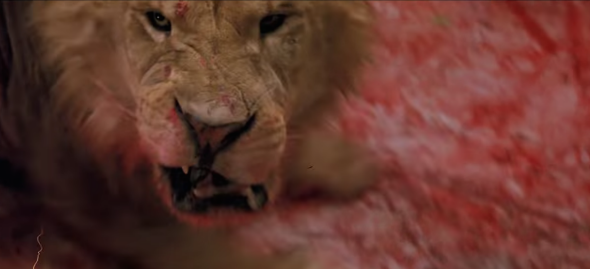Tippi Hedren is probably best known for being attacked by Mother Nature in The Birds, and based on her own account, shooting that film with Alfred Hitchcock was a nightmare. “Everybody had lied to me,” she has said. “When I got to the set I found out there had never been any intention to use mechanical birds … and there were boxes of ravens, gulls, and pigeons that bird trainers … hurled at me, one after the other, for a week.”
Perhaps the memories of that excruciating experience had faded some years later when she and her then-husband, Noel Marshall, decided to secretly breed wild lions in their home. This incredibly dangerous experiment intended to raise awareness about the overhunting of big cats became the mostly forgotten 1981 film Roar. Thirty-four years later, it’s now being re-released by Drafthouse Films and Olive Films, and will appear on DVD and Blu-Ray later this year. If the whole idea of living with untrained lions and tigers sounds insane, well, the result was as terrifying as you’d expect:
On the Drafthouse website, the company’s CEO and co-founder Tim League has detailed just how over-the-top and out-of-control the entire project was. Hedren and Marshall eventually accumulated more than 100 big cats and moved to a bigger compound, along with their four children (one of whom was a young Melanie Griffith). Production, which spanned more than 11 years, was complete chaos:
The cast and crew endured countless injuries, with over 70 bloody attacks documented. While nobody was killed, there were several close calls, most notably [cinematographer Jan] de Bont [who went on to direct Speed] being scalped by a lion resulting in 220 stitches on his head. Hedren endured a fractured leg and deep scalp wounds. Griffith was mauled by a lion, resulting [in] over 100 stitches and reconstructive surgery. Noel was gored so many times that he was eventually hospitalized with gangrene. Maintaining a consistent crew became virtually impossible as injuries and safety risks kept them from returning to set.
Ultimately, the movie would be heralded in Variety as “the most disaster-plagued pic in Hollywood history.” It wound up being a huge box office flop, but League calls it “the most epic and amazing animal thriller ever made.”
How this film hasn’t gained a bigger cult following is beyond me—it looks like Grizzly Man to the nth degree (and without such a sad ending). It’s doubtful that Hedren and Marshall’s folly did much, if anything at all, to help with the preservation of big cats, and the message of their production might not have been as intended, but they do appear to have succeeded in creating a fascinating cinematic experiment.
Previously
Yes, Zoo Lions Really Do Want to Eat Your Children
